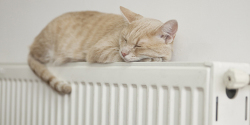

Following the launch of the domestic renewable heat incentive, the Manufacturers' Association of Radiators and Convectors (MARC) makes the case for radiators and renewable systems
Historically there has been a misconception that radiators are less energy efficient than some other heat emitters when used with low water temperature systems.
In fact modern high performance steel panel radiators work well with low water temperatures, making them an ideal choice for eco-conscious developers and homeowners.
This has been driven by the introduction of modern insulation materials and standards, bringing significant reduction in heat losses and, therefore it may no longer be necessary to heat water to 80°C in order to achieve a room temperature of 20°C.
A property with a high efficiency heat source, panel radiators and water at 40°C- 50°C uses less energy and will quickly achieve a room temperature of 20°C.
Modern panel radiators need only small volumes of warm water to operate efficiently and so work well with all heat sources. They start performing as soon as the water in the system, and therefore the panel, becomes warmer than the surrounding space. Low water temperature heating systems using modern panel radiators are one of the most efficient ways of using heating energy to deliver warmth.
Innovation in panel radiators means modern units use less steel, have lower water content, utilise convector fins and incorporate individual thermostatic valves; providing efficiency, comfort and versatility.
Development also denotes that radiators no longer need to take up large areas of wall space; however size is a factor when considering low temperature systems.
Radiators for low temperature systems are physically and technically the same as traditional panel radiators, but, the same size of radiator will not produce the same heat output with a low temperature system as it will with a high temperature system. To achieve this you will generally need to fit radiators that have larger surface areas.
Innovative developments in radiator design pack more surface area in a smaller wall space than ever before.
The modern day radiator can also work effectively alongside underfloor heating, and it is possible to use the same heating water for both. The latest SAP 2012 document has specific criteria for energy efficient low temperature heat generators and states that radiators are as efficient as other heat emission systems, such as underfloor heating.
In addition radiators today are not only compatible with current building methods and skills sets, they are flexible and reactive; responding to the real time temperature needs and reacting to secondary gains e.g. people.
Due to their flexibility, steel panel radiators and convectors are the best way of introducing energy-efficient heat generators into existing properties, with renovation and retro-fit accounting for in excess of 90% of the UK and other major western European markets.
Not forgetting that radiators have undergone something of a renaissance in the last decade or so. In line with people's aspirations to create beautiful and unique homes that match their taste and lifestyle, the radiator has not been forgotten. Indeed, options in material, colour and design have meant it has become something of a work of art in itself.
Heating our homes is both a necessity and a pleasure. While the summer breeze and sounds of the shore may need to be improvised, warming yourself by the radiator is a similarly pleasurable experience to soaking up the summer sun.
In reality, nobody has found anything better than the radiator. While other types of heating system have emerged as popular options, the steel panel radiator can and does compete on all levels and is still very much the number one choice.
MARC is a member organisation established to give a collective voice to the radiator and convector industry, focussing on the specific needs of, and issues faced by, manufacturers. MARC is a division of the Energy and Utilities Alliance (EUA).
If you'd like to keep up-to-date with the latest developments in the heating and plumbing industry, why not subscribe to our weekly newsletters? Just click the button below and you can ensure all the latest industry news and new product information lands in your inbox every week.